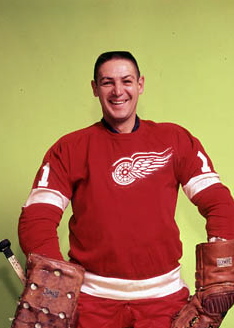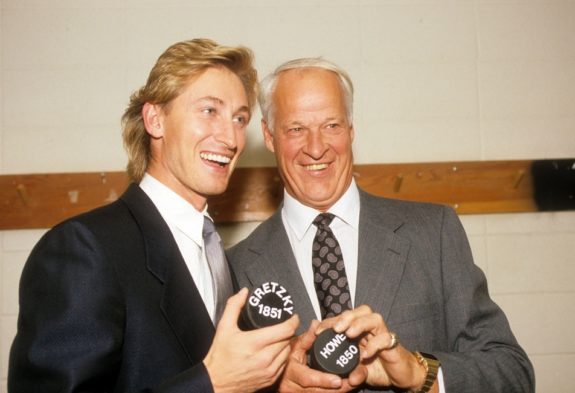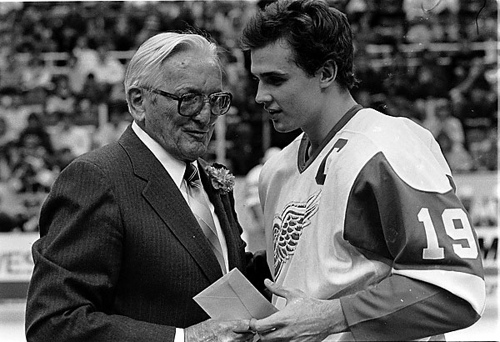The “12 Days of Christmas” is a classic holiday song first published in its current form in 1908. In a nod to the classic carol, join The Hockey Writers as we count down the 12 Days of Hockeymas. Each day, we will provide you with a piece of hockey history as we eagerly await the start of the 2020-21 NHL season.
When compared to their Original Six foes across the Canadian border, the Detroit Red Wings have a small amount of retired number hanging in the rafters of their home arena. That’s not to say that they have had fewer players worthy of that honor; in fact, many would argue that there are a number of former Red Wings that deserve the honor of seeing their number enshrined in “Hockeytown” lore. But, in the spirit of the holidays, we’re not going to focus on what we want. Instead, we’re going to appreciate what we already have.
As of December 2020, the Red Wings have only retired eight numbers in their franchise’s history. In some ways, this is the most prestigious club in Detroit sports – and for good reason. These numbers span across several generations of the team and its fans. If their numbers aren’t well-known across the league, then their names likely are.
So, on the eighth day of Hockeymas, let’s take the time to appreciate the lives and careers of these eight wise men.
1 – Terry Sawchuk
For a lot of fans, the symbol of Red Wings goaltending is the “old-school” mask worn by former goaltender Chris Osgood. But before “Ozzy” wore that iconic helmet, a man who occasionally wore a face mask or even no helmet at all set the franchise’s standard for goaltending.

Honestly, it’s pretty fitting that Sawchuk wore the number one. To this day, despite the fact that he played his final games with the Red Wings during the 1968-69 season, holds nearly every major goaltending record for the franchise. His 350 wins are the most in franchise history, and his 85 shutouts are 46(!) ahead of second place. In fact, his 103 career shutouts are behind only Martin Brodeur for the most in league history. He won the Vezina Trophy as the league’s top goaltender four times, and was inducted into the Hockey Hall of Fame in 1971.
Despite his untimely death in 1970, Sawchuk’s legacy lives on not just in the record books, but in the goalies he helped inspire. He was a brick wall in the net in the era before the butterfly technique took the league over. While you may not have seen his iconic number one in action, you can still see his influence on the game to this day.
4 – “Red” Kelly
The newest member of this prestigious club, Kelly’s number four was retired on February 1, 2019 ahead of a game between the Red Wings and the Toronto Maple Leafs – who also have retired Kelly’s number. Over his 20-year career, he played both center and defense, and has the distinct honor of having won the first ever Norris Trophy as the league’s top defender.
Kelly won the Lady Byng Trophy as the league’s “Most Gentlemanly” player four times in his career, three of them coming with the Red Wings. And yet, despite all of this, his time with the Red Wings was cut short when former general manager Jack Adams chased him out of town after he divulged to the media that he played on a broken ankle through the year 1959. He went on not only to have a successful run with the Maple Leafs, but he also became a member of Canada’s parliament from 1962 to 1965.
5 – Nicklas Lidstrom
Known affectionately as “The Perfect Human”, Lidstrom is not only the best defenseman in franchise history, but one of the best defenders to ever play the game. In terms of awards, he is also one of the most decorated defenders in the history of the game.

From 2001 to 2008, Lidstrom won two Stanley Cups (2002, 2008), the Conn Smythe Trophy as playoff MVP (2002), an Olympic gold medal (2006), and SIX Norris Trophies. In total, he won the Norris seven times, tying him with Doug Harvey for the second-most all-time. He was a finalist for the award 11 times. He also took on the daunting task of wearing the captain’s “C” following “The Captain” Steve Yzerman’s retirement in 2006.
The Red Wings’ run of success from the early 90’s to the mid 2010’s directly correlates to Lidstrom’s time with the team. Though the Red Wings made the playoffs four more years after he retired in 2012, they were never the same and their decline was inevitable. Today, he lives in his native Sweden, but his legacy lives on through the streets of “Hockeytown” and the rafters of Little Caesar’s Arena.
7 – “Terrible” Ted Lindsay
Pests today are nothing like the pests of yesteryear. But just like today, the best pests are the ones that can back up their antics with production on the ice. In the case of the Red Wings’ iconic number seven, the opposition absolutely hated to go up against the guy they called “Terrible”: Ted Lindsay.
Despite standing at just 5-foot-8, Lindsay brought intensity to nearly every game he played. As a part of the famed “Production Line”, he collected 728 points through 862 regular season games with the Red Wings. During his time in Detroit, he also racked up a whopping 1,423 penalty minutes. Despite his nastiness on the ice, his lasting legacy was founded on the principal of empathy.
It was Lindsay who risked a great deal when he founded the NHL Player’s Association. In fact, his willingness to stand up for his fellow players’ rights rubbed ownership the wrong way, and because it, he was traded to the Chicago Blackhawks despite having a career-year the season prior. After three years there, he made his way back to Detroit, where he played his final season in the NHL.
To this day, the Ted Lindsay Award is given to the league’s most valuable player, as voted on by the Players’ Association. It’s safe to say that his number seven means a lot across the league – not just in Detroit.
9 – Gordie Howe
With a nickname like “Mr. Hockey”, you’ve got to know that this guy was a living, breathing legend. Today’s young hockey players aspire to be like Wayne Gretzky. Well, Gretzky aspired to be like Gordie Howe.
One look at the Red Wings’ record book and you’ll see Howe’s name plastered all over it. He played 25 years with the Red Wings, and along the way became the greatest hockey player of his time. A member of the “Production Line” with Lindsay, he was just as willing to engage in the rough stuff – after all, this was a time when helmets were far and few in between. His 1,767 career regular season games still stands as the most in NHL history (as of this writing) and it speaks not only to his longevity as a player, but his ability to remain an impactful forward well into his 40’s.

When Howe passed away in 2016, it sent shockwaves throughout the entire hockey community. Few players can say they are among the best to play for a certain franchise; even fewer get to say that they are among the best to ever play the game. “Mr. Hockey” is among those select few.
10 – Alex Delvecchio
Before “The Captain”, there was captain Alex Delvecchio. His 12 seasons as the Red Wings’ captain is second only to Yzerman, but that’s not the only reason his iconic number 10 is retired. With 1,550 regular season games played across 24 seasons, he ranks second in franchise history behind only Lidstrom.
Delvecchio was one of two players to skate with Lindsay and Howe on the “Production Line”, and while his point totals never reached the heights of “Mr. Hockey”, his 1,281 career points are nothing to scoff at. Following his Hall of Fame playing career, he spent three years as the Red Wings’ coach and general manager – though he didn’t have nearly as much success in those positions as he did at center and left wing.
Delvecchio is one of three players (the others being Lindsay and Howe) to have a bronze statue on the concourse of Little Caesar’s Arena.
12 – Sid Abel
Abel has the distinction of being just the second Red Wing ever to win the Hart Trophy as league MVP, doing so in 1949. Beyond that, he was the fourth and final member of the “Production Line” and even served in the Royal Canadian Air Force during World War II.

Abel served as the captain of the Red Wings starting in 1942, and wore that letter (excluding the period of time where he was off at war) all the way to 1952 when he was dealt to the Blackhawks. An astute player with a mind for the game, he served as the Blackhawks’ “player-coach” – the last guy to ever hold such a role in the NHL.
Following his playing career, he served as the coach of the Red Wings from 1957 to 1970, and as their GM from 1962 to 1971. To finish his career in the game, he was a color commentator for the Red Wings through the 80’s. He never scored like Gordie, be he held the Red Wings just as close to his heart as “Mr. Hockey” did.
19 – Steve Yzerman
“The Captain”. From the age of 21 all the way to his retirement at the age of 40, Yzerman wore the captain’s “C” on his jersey and became a Detroit-sports icon along the way. Whether it was collecting 155 points during the 1988-89 season or putting his body on the line during the Red Wings’ Stanley Cup runs, he did everything and anything his team needed from him.
Over his career, he won three Stanley Cups, one Lester B. Pearson Award (now known as the Ted Lindsay Award), the 1998 Conn Smythe Trophy, a Selke Trophy, and the Bill Masterton Memorial Trophy in 2003 for his dedication to hockey on and off the ice. He did it all on the ice, and now he’s trying to do it all from the front office as the Red Wings’ GM. Quite frankly, he might be the most popular GM the Red Wings have ever had.
Who’s Next?
Kelly waited well over 50 years for the Red Wings organization to retire his number four. What that should tell you is that even though certain players have yet to see their numbers retired, it can still happen. Given the franchise’s relatively small amount of retired numbers, this is a group that is among the most exclusive in the state of Michigan. It goes without saying that the Red Wings have more than a few players that could one day join this list – it’s just a matter of when.
What number do you think the Red Wings will retire next? Share your thoughts in the comments down below.
Catch Up on All 12 Days of Hockeymas:
12 Years Since Winning the Cup
11 Stanley Cups in Franchise History
10 Hall of Famers on 2002 Stanley Cup Team
9 James Norris Memorial Trophies